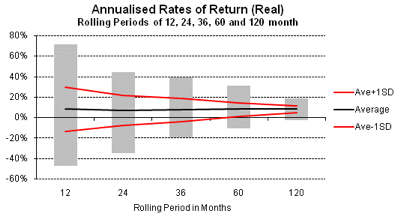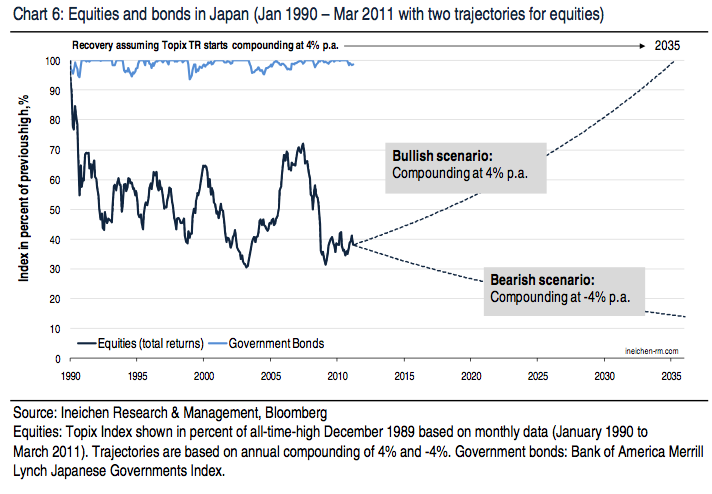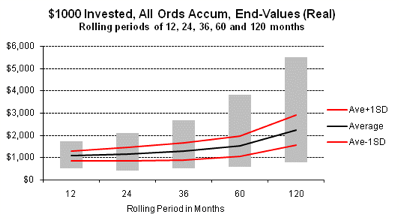Time heals all wounds. As in life, as in investing. Or so the average financial adviser will tell you.
The standard argument goes as follows. If your investment horizon is long enough, any bad years in the share market will be ironed out by the upward trend over the long term. Stay the course, and you’ll be fine. Equities might underperform bonds or cash over the next few years. But over 5 years? 10 years? 30 years? Unlikely. So goes the story.
However, there is a fatal omission in this argument, which I outlined in my previous post concerning risk and investing. While your investment returns can compound nicely over the long term, so does the uncertainty surrounding these returns.
One of our readers, Brent (aka BB) has sent in two excellent charts (originally from Paul Resnik at Finametrica) that illustrate this point very well.
Many of you will have seen a variant of the chart below, which shows that the longer the time horizon of your investment (in this case using historical returns for the All Ordinaries), the less variability in your expected returns. The red lines represent one standard deviation above and below the mean. If you don’t remember what standard deviation is, no problem. The chart is just illustrating that the longer the period of investment in the stock market, the more predictable your annualized return becomes. This concept is known as “time diversification”.
Similar charts are often used to argue that young savers (in their 20s and 30s, for example), should have a high proportion of their investment portfolios in growth assets like equities. While equities are more volatile than bonds, they have historically offered greater return potential. This volatility can be smoothed out by investing over the long term, reducing risk.

However, while this chart may look very convincing on the surface, it is actually presenting a very misleading picture. Why? What matters to an investor is not the annualized return, but the total return on the investment at the end of the period. And the longer the period of investment, the greater the uncertainty surrounding this total return:
The range of potential outcomes increases over time, not decreases, as small variations in percentage returns generate large variation in end dollar values. Granted, the magnitude of absolute negative returns is decreased (based on All Ords performane between 1972 and 2009) but perhaps this is the message that should be taken from long-term return assumptions.
Yes, the likelihood of negative real returns is diminished over long holding periods, but your range of likely return outcomes remains far more uncertain than traditional rhetoric would suggest.
As I noted in my previous post, over the longer term, there is also a greater risk of unexpected “black swan” type events wiping out your investment. As Alexander Ineichen says, “if accidents happen in the short term, one might not live long enough to experience the long term.” Furthermore, by putting all our chips on the long-term appeal of equities, we are unwittingly making some very big assumptions. When you consider the aging of our population, who’s to say that equity returns will be as strong in the future as they have been over the past few decades?
Once again, let’s look at the case of Japan, where the TOPIX share index is still 60% below its 1990 high.
 As Ineichen says:
As Ineichen says:
The first dotted line assumes the Topix Index starts compounding at 4% per year. In such a scenario the index would reach its all-time-high from December 1989 around the year 2035.
Equities are expected to rise in the long run, i.e. time is supposed to diversify/reduce risk. However, from January 1990 to March 2011 the Topix TR (total returns) Index compounded at an annual rate of -4.4%. That’s the trend.
The second trajectory in Chart 6 shows the index assuming compounding continues at -4% per year. In theory, buyers should come in when there are valuation differences. In practice, the theory doesn’t seem to hold up very well. We do acknowledge that mean reversion is one of the most powerful concepts in finance (dead cats nearly always bounce). However, it doesn’t always seem to work. Or it might take too long to be a practical concept to bet on. There is uncertainty regarding the reversion to the mean.
So what are the practical implications of all this? You don’t have to believe we’re turning Japanese to be troubled by the chart above. The point is that long-term equity investors are subjecting themselves to enormous uncertainty.
This doesn’t mean we shouldn’t invest in equities for the long term. For people willing to put in the research, there will often be good shares available at a good price. But it does suggest the standard advice that young savers should have close to 100% of their retirement funds in growth assets such as equities, is far more dangerous than is commonly appreciated. As The Prince has noted in his excellent series on superannuation, the so called “balanced” default option for most Australian super investors is not balanced at all.
A truly balanced option would have a far greater allocation to fixed interest (including cash). Just don’t expect your financial adviser to tell you this in a hurry.
